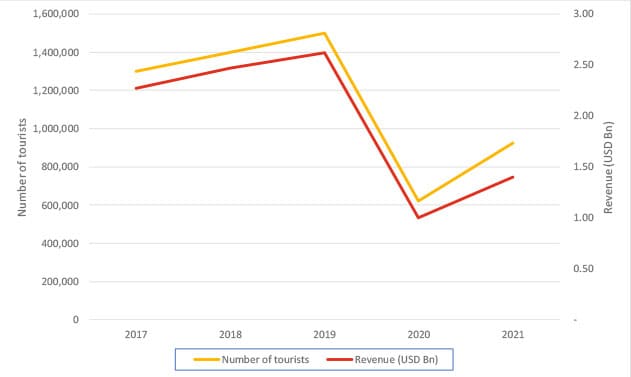The future of Tourism in Tanzania
01/09/22
Let’s reimagine the future of Tourism in Tanzania
Tanzania’s tourism sector is seeing a rebound after the Covid-19 pandemic—and the aspirations for its continued growth are high: by 2025, the country hopes to reach $6 billion in tourism revenue, which assumes the influx of five million tourists annually. To achieve such lofty goals will require some important upgrades and improvements to tourism infrastructure and services. I outline a few of them in this article.
Before the pandemic, tourism was the largest foreign exchange earner, the second largest contributor to the gross domestic product (GDP) and the third largest contributor to employment. After taking a severe hit during Covid, tourists are starting to return to Tanzania, with 742,133 visitors between January and July 2022, a 62.7% increase over the previous year (Exhibit 1).

Exhibit 1: Tourism is returning after the Covid-19 pandemic
But whilst we are doing well, many bottlenecks persist. These include limited access to cheap financing, inadequate tourism infrastructure, a multiplicity of levies, insufficient diversity in products offerings, and lack of sufficient hotel and airport facilities. So how can we measure how we are doing?
Well, the World Economic Forum (“WEF”) in its Travel & Tourism Development Index 2021 (published in May 2022, and themed “Rebuilding for a Sustainable and Resilient Future”) is one barometer of where we stand. It ranks Tanzania as 5th of the sub-Saharan African (SSA) countries (and 81st globally out of 117 countries, up from 86th in 2019). 1st to 4th places within SSA are taken by Mauritius (62nd), South Africa (68th), Botswana (76th) and Kenya (78th), with 6th to 10th places taken by Cape Verde (82nd), Namibia (88th), Rwanda (89th), Zambia (98th) and Ghana (101st).
According to the WEF report Tanzania and South Africa are very clear leaders within SSA in terms of ranking of natural resources. One aspect to consider further as a significant opportunity is the “non-leisure resources” pillar, which measures the extent and attractiveness of factors that drive business and other non-leisure travel; although Tanzania’s ranking is broadly in line with the SSA average, it does lag Kenya and South Africa by quite a bit. More generally, the WEF report does highlight that East Africa as a region does not rank as highly as Southern Africa in terms of price competitiveness.

Exhibit 2: Tanzania can do more to boost its tourism competitiveness
Tourists coming to Tanzania frequently speak of seeing “the Big Five”. Stakeholders in the tourism sector would also say that they have their “Big Five” namely the “Five A’s”: Attractions, Access, Accommodation, Amenities, and Affordability! From my perspective, and aligned with this, I would highlight some priority areas that need to be addressed by the government and other stakeholders in the tourism sector.
Reduce multiplicity in levies and taxes. There is a need for a fresh look at tourism taxes and levies so as to reduce multiplicity and create competitiveness across the region – indeed, this point was highlighted as an urgent priority in a report recently presented at the 13th meeting of the Tanzania National Business Council. Currently, Tanzania is deemed an expensive destination compared to other destinations such as South Africa and Kenya. Notwithstanding the positive efforts which led to reduction of some of the levies such as the Tourism Agency License (TALA) fee, there is still scope for rationalization of fees that are charged by multiple government agencies. Further, stakeholders’ engagement prior to fee changes will smoothen the operations of the tourism firms and attract more investments in the sector.
Affordable financing. Tourism firms across the sector, as well as those in downstream value chains, need access to affordable finance particularly in this post Covid-19 era, when the risk appetite for financial institutions in the tourism market is very low. Support from International Development Agencies (IDAs) on the tourism sector should be sought for development projects that have a direct economic impact on the sector and the country as whole.
Improved infrastructure. Tanzania ranks higher than Kenya with respect to safety and security, but lower than Kenya when it comes to tourist service infrastructure. For instance, the drive from Dar es Salaam to Selous Game Reserve, the largest game reserve in Africa is bumpy and long, taking an average of 7 to 8 hours. Flying is a better one option and the fastest way to get to Selous. However, it is the most expensive and hence suits more high-end tourists. Again, IDA support to improve tourist service infrastructure could give a welcome boost.
Upgraded hotels and airport facilities. More effort is required to attract private sector investment in hotels and ensure diversity in service offerings. The current hotel capacity in both Mainland and Zanzibar cannot cater for the expected influx of 5 million tourists by 2025. Improvement in efficiencies and flight handling capacity at the airports is another area which requires fixing. Automation of immigration procedures in Zanzibar and Kilimanjaro Airports will help fast track the process. Instead of having a paperwork checking system, barcodes should be set to scan all the documents. This will help to reduce unnecessary queues at the airports during high season.
Diversified tourism products. Other than wildlife and beaches, the Ministry for Tourism should spearhead the innovation of new tourist attractions. The recent decision to market Ngorongoro-Lengai geo park and the introduction of “Mice” (meetings, incentives, conferences, and exhibitions) are commendable efforts as these will boost tourism income, since Tanzania is an already established adventure destination.
Introduction of direct flights and collaborations with aviation industry. The signing of a memorandum of understanding between the Tanzanian Government and Dallas in April 2022 was one of the great achievements of the Royal Tour of the United States by her Excellency Samia Suluhu Hassan, as this will attract more American visitors to Tanzania's tourist destinations. More direct flights need to be added to key markets while maintaining a closer collaboration between the aviation and tourism industries for sustainable growth of the sector. This will ease flight interconnectivity to tourists who prefer to do inter-connected travels.
Raising public awareness. More education is needed for the public and journalists to help promote the tourism sector. Although we are in the era of freedom of speech, care should be taken not to exaggerate unproven facts that are detrimental to the sector’s growth.
In conclusion, the target of $6 billion by 2025 is achievable—but it will require deliberate efforts to make it a reality. The President’s Royal Tour is expected to bring a significant boost to the numbers in 2022 and beyond. The tourism sector needs to be given the utmost priority due to its huge potential in transforming the country’s economy as the sector contributes significantly to foreign exchange and employment.
By Zainab Salome Msimbe is a Partner with PwC Tanzania
Contact us








